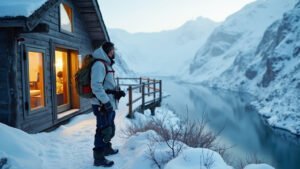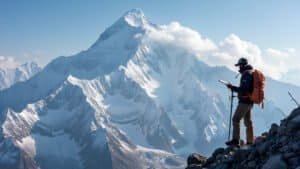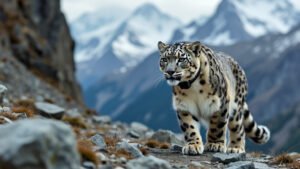Introduction
Camera traps have revolutionized wildlife research, offering a non-intrusive way to study elusive species like the snow leopard. These devices capture images and videos automatically, providing researchers with valuable data on animal behavior, population dynamics, and habitat use
This article explores how camera traps work, the challenges of studying snow leopards, the type of data collected, and the critical role these tools play in conservation efforts. We will also discuss best practices for setting up and maintaining camera traps to ensure effective data collection in the field
Understanding Camera Traps
Camera traps have become indispensable tools in wildlife research, offering a unique and effective way to monitor and study animals in their natural habitats. These devices are particularly useful for studying elusive and nocturnal species, such as snow leopards, which are notoriously difficult to observe directly
What Are Camera Traps?
Camera traps are automated devices equipped with motion sensors and cameras. When an animal passes by, the sensor triggers the camera to take a photograph or video
These traps can be left in the field for extended periods, allowing for continuous monitoring without human presence. Modern camera traps are equipped with various features, including infrared capabilities for nighttime photography, weatherproof housings, and high-resolution imaging
How Do Camera Traps Work?
The basic operation of a camera trap involves three key components: the motion sensor, the camera, and the storage system. The motion sensor detects movement within a certain range, which activates the camera
Once triggered, the camera captures an image or video, which is then stored on a memory card. Many camera traps also have time-lapse and burst mode settings to capture multiple images in quick succession, providing a more detailed view of animal behavior
Infrared sensors enable camera traps to work efficiently in low-light conditions, making them ideal for studying nocturnal animals. The captured images often include metadata such as the date, time, and location, which is crucial for analyzing animal activity patterns and movements
Technological Advancements in Camera Traps
Recent technological advancements have significantly enhanced the capabilities of camera traps. High-resolution cameras now provide detailed images that can help identify individual animals based on unique markings
Some camera traps are equipped with cellular or satellite connectivity, allowing researchers to receive images in real-time and remotely monitor their equipment. This real-time data transmission is especially valuable in remote or inaccessible areas, reducing the need for frequent field visits
Other innovations include improved battery life, larger storage capacities, and advanced sensors that can differentiate between animal species based on size, shape, and movement patterns. Additionally, some camera traps incorporate artificial intelligence (AI) to automatically sort and analyze images, identifying species and behaviors with greater accuracy and efficiency
Challenges of Studying Snow Leopards
Snow leopards, known for their elusive nature and inhospitable habitats, present numerous challenges to researchers. These factors make the use of camera traps particularly valuable in studying these majestic but hard-to-find animals
Elusiveness of Snow Leopards
Snow leopards are solitary and highly elusive animals. They inhabit remote and rugged mountainous regions across 12 countries in Central and South Asia
Their natural camouflage makes them almost invisible against the rocky terrain, and they are primarily active during dawn and dusk, further complicating direct observation. The rarity of sightings and the wide-ranging territories they cover make traditional tracking methods inefficient and often unfeasible
Harsh Habitats
The snow leopard’s habitat includes some of the most challenging and extreme environments on Earth. These big cats are found at elevations ranging from 9,800 to 17,000 feet, in areas with harsh weather conditions, including extreme cold, heavy snowfall, and rugged, steep terrain
These conditions pose significant logistical challenges for researchers, including the difficulty of accessing study sites, the need for specialized gear, and the physical demands of working in such environments. Camera traps, being resilient and capable of withstanding harsh weather, provide a practical solution to these challenges
Human and Environmental Factors
Human activities such as poaching, habitat destruction, and climate change further complicate the study of snow leopards. Poaching not only reduces snow leopard populations but also makes them more wary of humans, driving them deeper into inaccessible areas
Habitat destruction from infrastructure development and mining forces snow leopards to relocate, often to even more remote and rugged terrains. Climate change is altering the ecosystems snow leopards depend on, affecting prey availability and habitat conditions
Additionally, political instability and border conflicts in some snow leopard range countries can restrict research activities and pose safety risks for field researchers. Camera traps allow for continuous, long-term monitoring in these politically and environmentally volatile areas without putting researchers at risk
Data Collection and Analysis
Camera traps play a crucial role in gathering detailed and extensive data on snow leopards, providing insights into their behavior, population, and habitat use that would be difficult to obtain through direct observation
Types of Data Collected
Camera traps collect a variety of data, including photographic and video evidence of snow leopards in their natural habitats. The primary data include:
Images and Videos: High-resolution images and videos capture snow leopards’ physical characteristics, behaviors, and interactions with their environment and other animals
Time and Date Stamps: Each image and video is tagged with a timestamp, allowing researchers to determine the time of day when snow leopards are most active
Location Information: GPS coordinates associated with each capture help map snow leopard territories and movement patterns
Environmental Data: Some advanced camera traps can also record environmental conditions such as temperature, humidity, and light levels at the time of capture
Behavioral Insights
Camera traps provide invaluable information on snow leopard behavior. By analyzing the collected images and videos, researchers can study various aspects of their behavior, including:
Activity Patterns: Determining periods of high and low activity helps in understanding snow leopard daily routines and seasonal behaviors
Hunting and Feeding: Observing snow leopards hunting and feeding offers insights into their prey preferences and hunting strategies
Social Interactions: Capturing interactions between individuals can reveal social structures, mating behaviors, and territorial disputes
Parental Care: Footage of females with cubs provides information on reproductive success and cub survival rates
Population Estimates
One of the most critical uses of camera trap data is estimating snow leopard populations. This process involves:
Individual Identification: Unique physical markings, such as rosette patterns on the fur, allow researchers to identify individual snow leopards. Advanced software aids in this identification process by comparing patterns across multiple images
Density Estimates: By calculating the number of individuals in a given area, researchers can estimate population density, which is essential for understanding the species’ distribution and abundance
Demographic Data: Data on age, sex, and health of individuals contribute to demographic studies, helping to assess the overall health and viability of snow leopard populations
Conservation Efforts
Camera traps are not just tools for studying snow leopards; they are instrumental in informing and enhancing conservation efforts. By providing critical data, these devices help conservationists develop strategies to protect snow leopards and their habitats
Role of Camera Traps in Conservation
Camera traps contribute to conservation in several ways:
Monitoring Populations: Regular monitoring helps track population trends over time, allowing conservationists to detect declines early and take proactive measures
Identifying Threats: Images can reveal poaching activity, illegal wildlife trade, and human encroachment, which are significant threats to snow leopards. This information is vital for law enforcement and anti-poaching efforts
Understanding Habitat Use: Knowing which areas are most frequented by snow leopards helps prioritize habitat protection and management efforts. This includes creating and maintaining wildlife corridors to ensure genetic diversity
Assessing Conservation Interventions: By comparing data over time, researchers can evaluate the effectiveness of conservation strategies, such as protected areas or community-based conservation programs
Success Stories and Case Studies
Several success stories highlight the impact of camera traps on snow leopard conservation:
Snow Leopard Trust: This organization uses camera traps extensively across various snow leopard habitats. Their data has led to better protection measures in countries like Mongolia and India. For instance, in Mongolia’s Tost Tosonbumba Nature Reserve, camera trap data helped secure the area as a protected region, significantly reducing mining and poaching threats
Panthera: Panthera’s snow leopard program has employed camera traps to create one of the largest photo databases of snow leopards. Their research has informed national conservation policies in Kyrgyzstan and Tajikistan, leading to the establishment of new protected areas and improved anti-poaching efforts
Citizen Science Projects: Initiatives like the Global Snow Leopard and Ecosystem Protection Program (GSLEP) involve local communities in setting up and monitoring camera traps. This not only provides valuable data but also raises awareness and fosters community support for snow leopard conservation
Future Directions in Conservation
Looking ahead, the integration of camera trap data with other technologies and approaches offers exciting possibilities for snow leopard conservation:
Artificial Intelligence (AI): AI can automate the analysis of vast amounts of camera trap data, identifying individual animals and behaviors more quickly and accurately than manual methods. This increases the efficiency of monitoring programs and allows for more timely interventions
Genetic Analysis: Combining camera trap data with genetic analysis from collected samples (e.g., scat or fur) can provide deeper insights into snow leopard populations, including genetic diversity and relatedness
Collaborative Platforms: Online platforms where researchers share camera trap data globally can enhance collaborative conservation efforts. Shared databases can lead to more comprehensive understanding and coordinated action across snow leopard range countries
Setting Up and Maintaining Camera Traps
Effective use of camera traps for studying snow leopards requires careful planning, strategic placement, and regular maintenance. This section outlines best practices for maximizing the efficiency and longevity of camera traps in the field
Best Practices for Placement
Site Selection: Choose locations based on snow leopard activity indicators such as tracks, scat, and scrape marks. Areas near water sources, ridgelines, and trails are often frequented by snow leopards
Height and Angle: Position the camera trap at a height of about 1.5 to 2 feet above the ground, angled slightly downward. This setup increases the likelihood of capturing clear images of the entire animal
Camouflage: Use natural materials like rocks and vegetation to camouflage the camera trap. This minimizes disturbance to wildlife and reduces the risk of theft or vandalism
Trigger Settings: Adjust the motion sensor sensitivity and trigger interval based on the specific study goals and environmental conditions. For example, in areas with frequent movement from smaller animals, lower the sensitivity to avoid excessive non-target captures
Maintenance and Data Retrieval
Regular Checks: Schedule regular visits to the camera trap sites to check the equipment, replace batteries, and swap out memory cards. The frequency of these visits depends on the camera model, battery life, and the amount of activity in the area
Battery Management: Use high-capacity lithium batteries for longer life, especially in cold environments where battery performance can decline. Carry spare batteries during each field visit
Data Backup: Immediately back up data from memory cards to multiple storage devices to prevent data loss. Label and organize files systematically to facilitate later analysis
Firmware Updates: Keep the camera trap firmware up to date to ensure optimal performance and access to the latest features and bug fixes
Overcoming Challenges in the Field
Weather Conditions: Extreme weather can impact camera trap functionality. Use weatherproof and ruggedized camera traps designed to withstand harsh conditions. Protective casings and covers can provide additional defense against the elements
Animal Interference: Wildlife can sometimes damage or move camera traps. Secure the camera traps firmly and consider using protective housings to deter tampering
Human Interference: In areas with potential human activity, discreet placement and camouflage are essential to reduce the risk of theft or vandalism. Use lockboxes and security cables for added protection
Technical Issues: Be prepared to troubleshoot common technical issues such as sensor malfunctions or data corruption. Carry essential tools and replacement parts during field visits to address these problems promptly
Conclusion
Camera traps have transformed the study and conservation of snow leopards, offering invaluable insights into the lives of these elusive big cats. By understanding how camera traps work, the challenges of studying snow leopards, the data they provide, and their role in conservation, we can appreciate the significant impact of this technology
Researchers use camera traps to gather detailed data on snow leopard behavior, population dynamics, and habitat use. These devices help overcome the difficulties posed by the snow leopards’ elusive nature and harsh habitats
Camera traps have proven essential in identifying threats, monitoring populations, and informing conservation strategies. They also allow researchers to set up and maintain monitoring systems efficiently, even in challenging environments
The technological advancements in camera traps, such as AI integration and improved sensors, continue to enhance their effectiveness. With ongoing innovation and collaborative efforts, camera traps will remain a cornerstone of snow leopard research and conservation, providing the critical data needed to protect these magnificent animals for future generations










